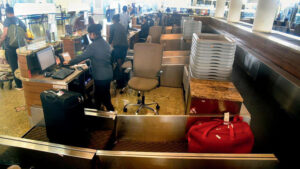DECEMBER 4, 2022

It was a secretive and low-key trip this writer and mid-day photojournalist Shadab Khan were invited to follow—the journey of our checked-in baggage to the airplane—and we went along for the ride. The bags are handled in the heart of the airport, and we had to undergo rigorous screening by the Central Industrial Security Force (CISF) to get there. The procedure started a few days in advance where we had to submit our Aadhar card and a photograph for identification and for the airport authorities to make a permit pass. This permit pass acted like our passport throughout the journey. Despite being with the officials and wearing an ‘Observer’ safety vest, we had to show our permit card to the CISF at all times. Though we were legitimately invited by Chhatrapati Shivaji Maharaj International Airport (CSMIA) to observe the process, we felt a bit weird about being in the airport without a ticket.
Inline screening, baggage operations and terminal operations officials took us through the process. After this experience, we learnt two things—one that our bag is not tampered by a human at any point of time and second is that it takes a maximum of 15 minutes for the entire bag to be screened and be ready for loading in the arlines’ container.
“Our system design has a capacity of 9,600 bags per hour, but in practicality, much fewer bags go through,” says a spokesperson from the CSMIA team proudly. On an average, 5,600 bags go through every hour, and the maximum number of bags they have handled in a day so far has been one lakh, and in a month, it has been over 27 lakh. The time taken by the bag from check-in till it’s packed in the airlines’ container is anywhere between four and 15 minutes. “Our motive is to keep the bags moving,” says the spokesperson.
Spread across a radius of 12 km, there are two exact sets of the complex mechanism described below. Both zones do the same function, and if one part of the 3,000-equipment machine is under maintenance, the load is diverted to the other system.
Stage 1
There are 14 check-in islands where the bags are weighed and checked in. The operator sticks on a tag with basic details such as name of the passenger and airline, number of bags, and flight number. That’s the last time the passengers see their bag. From there on, the first conveyor belt takes it through a systematic labyrinth below the airport. There are four levels a bag passes through once it is dispatched by the airlines staff. Larger bags, odd-shaped ones such as guitar cases, those holding sports equipment, fragile luggage and live animals go through the Super Out of Gauge (SOG) machines and screeners. There is a separate elevator for bags that could damage the conveyor. If the conveyor belt halts, up to 20 m of the belt will stop. An alarm rings and an operator checks the disruption.
Stage 2
Once checked-in, the bag goes through an X-Ray, one level down, transported on blue conveyor belts. At this level, all 14 check-in conveyor belts merge with the main system that has bags of all passengers. We are surrounded by conveyor belts. Multiple belts merge over our heads and by our sides. All are colour coded in blue, green and red. “Think of it as a road in Mumbai,” says a spokesperson. “The bag never stops, there are no traffic signals. Cleared or rejected, it is sorted into a dedicated belt.” It feels like the bowels of an enormous factory with whirring machines, beeping alarms and an eerie emptiness.
We clamber up steep industrial ladders, jump over convertible belts bearing suitcases, walk through the labyrinth surrounded by yellow and blue belts, looking out for overhead machines, all while ensuring strands of our hair do not get caught by a belt or machine.
Stage 3
All the lines merge, and set off for another round of screening. Eight X-Ray screeners look into each bag and send it off. Tags and CCTV cameras track each item, and if a bag does not reach the next checkpoint in 120 seconds, the system is alerted. Each level is isolated by fire shutters which seal off any blaze and stop it from spreading.
Stage 4
Once cleared by the X-Ray machines, the bags go through vertical separation—cleared bags are dropped down to a green conveyor belt; suspicious ones go to the red line. The Global Identification tracking system generates a number which can be used to identify any bag disturbed by
hand or otherwise.
So to put to rest any fear that our bags may be tampered with, rest assured, no human hand touches our bags, despite a staff of 40-50 hands that merely oversee its journey. To prove this, our guide tilts a bag and it rumbles down to the red line for further inspection.
Stage 5
The bags landing on the red line pass through another round of screening. If found dodgy, the owner is contacted. Earlier, the passenger had to be physically present when the bag is opened. “It was a waste of time, a physical inconvenience to walk here; a porter also had to be sent to accompany the passenger,” says a spokesperson. “Now, the passenger can see their bags being inspected through CCTVs and video screens.” On an average, only five to 10 per cent bags go into this red line.
Stage 6
The bags travelling the green line get on the Tilt-trays belt, which tilts them into the final conveyor belt. One loop has 274 trays, and each bag is neatly dropped into one. Auto-sortation technology and the tracking-tag guide this procedure; This is the heart of the system. The Tilt-trays have shuts which drop the bag on the respective conveyor belt as per the airlines.
Stage 7
We climbed down an industrial ladder to see the final conveyor belt that contained all the luggage dropped by the auto-seperation belt. Porters load them from here into a container wagon and drive off to the aircraft.
Stage 8
We also saw the room that stored the luggage of those in transit. The system informs which bag goes into which connecting flight, and they are sent on another conveyor belt to the green line (as they have already cleared security). To think that all of this happens in under 15 minutes!
Courtesy/Source: Mid-Day










































































































